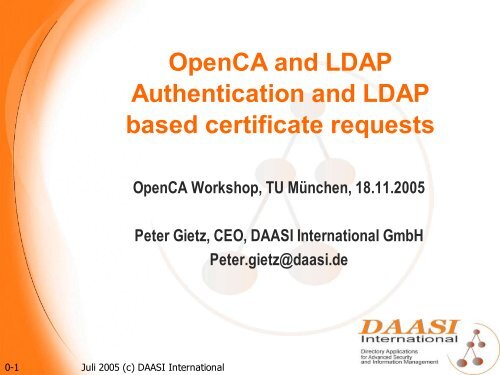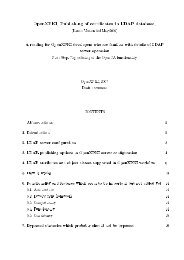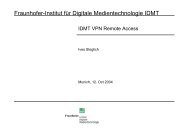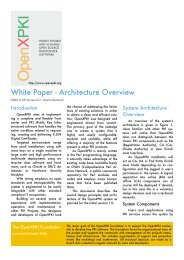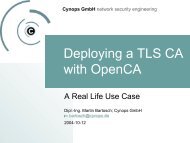Distributed LDAP and PKIs (Peter Gietz) - OpenXPKI
Distributed LDAP and PKIs (Peter Gietz) - OpenXPKI
Distributed LDAP and PKIs (Peter Gietz) - OpenXPKI
You also want an ePaper? Increase the reach of your titles
YUMPU automatically turns print PDFs into web optimized ePapers that Google loves.
OpenCA <strong>and</strong> <strong>LDAP</strong><br />
Authentication <strong>and</strong> <strong>LDAP</strong><br />
based certificate requests<br />
OpenCA Workshop, TU München, 18.11.2005<br />
<strong>Peter</strong> <strong>Gietz</strong>, CEO, DAASI International GmbH<br />
<strong>Peter</strong>.gietz@daasi.de<br />
0-1 Juli 2005 (c) DAASI International
Agenda<br />
Why Identity Management<br />
<strong>LDAP</strong> authentication in OpenCA<br />
<strong>LDAP</strong> based certificate request generation<br />
0-2 October 2005 (c) DAASI International
What is Identity Management?<br />
Spencer C. Lee:<br />
Identity management refers to the process of<br />
employing emerging technologies to manage<br />
information about the identity of users <strong>and</strong> control<br />
access to company resources. The goal of identity<br />
management is to improve productivity <strong>and</strong> security<br />
while lowering costs associated with managing users<br />
<strong>and</strong> their identities, attributes, <strong>and</strong> credentials.<br />
0-3 October 2005 (c) DAASI International
Why Identity Management?<br />
Publication of data about a person (White Pages Service)<br />
Non redundant data managementof staff data<br />
Consistency of data<br />
Fast automated provisioning of resources<br />
Fast automated deprovisioning after person leaves the<br />
organization<br />
Better inter domain communication: federated identity<br />
management (liberty, shiboleth, ws-fed)<br />
0-4 October 2005 (c) DAASI International
A few numbers from the Meta Group<br />
Meta Group: The Value of Identity Management:<br />
In Enterprises with over $500 Millionen revenue:<br />
45% of help desc activities is resetting passwords<br />
11% of employees have at least one access right<br />
problem per month<br />
Provisioning processes need between 6 <strong>and</strong> 29 hours<br />
Information about users is stored at 22 different data<br />
stores<br />
0-5 October 2005 (c) DAASI International
Worst Case Scenario at an University<br />
Telefondatenbase<br />
HR<br />
Students<br />
management-<br />
Email System<br />
Postal adresses<br />
management<br />
Listserver<br />
Login Management<br />
White pages<br />
service<br />
PKI system<br />
Print-servicese<br />
Alumni<br />
management<br />
Library user<br />
database<br />
Frau Musterfrau<br />
0-6 October 2005 (c) DAASI International
Central directory for a number of services<br />
IMAP<br />
server<br />
<strong>LDAP</strong>-master<br />
<strong>LDAP</strong><br />
<strong>LDAP</strong><br />
Email<br />
directory<br />
Web<br />
gateway<br />
Replication<br />
<strong>LDAP</strong><br />
Telephone<br />
directory<br />
Web<br />
gateway<br />
Data management<br />
loginserver<br />
Administrationsinterface<br />
1<br />
Administrationsinterface<br />
2<br />
<strong>LDAP</strong><br />
Course<br />
directory<br />
Web<br />
gateway<br />
Intranet<br />
0-7 October 2005 (c) DAASI International<br />
DMZ
Metadirectory solution<br />
HR<br />
Name,<br />
cost center<br />
Metadirectory<br />
Computer<br />
center<br />
user db<br />
Emailadress<br />
Telephone<br />
DB<br />
Telefonno.<br />
Library<br />
DB<br />
0-8 October 2005 (c) DAASI International
Metadirectory with provisioning<br />
HR<br />
Name,<br />
cost center<br />
Account<br />
DB<br />
Metadirectory<br />
ID/Passwd<br />
<strong>LDAP</strong><br />
Login server<br />
Non <strong>LDAP</strong><br />
enabled<br />
application<br />
<strong>LDAP</strong><br />
enabled<br />
application<br />
Linux<br />
client<br />
0-9 October 2005 (c) DAASI International
Provisioning vs. <strong>LDAP</strong> enabling<br />
Provisioning<br />
causes additional data redundancy<br />
Heterogeniuos Security mechanisms with different<br />
strengths<br />
Password changes are more complicated (different<br />
hashes)<br />
<strong>LDAP</strong> enabling<br />
Possible in any Open Source product<br />
Quite simple to do because of good <strong>LDAP</strong> libraries<br />
Password changes easy<br />
<strong>LDAP</strong> has a variety of strong <strong>and</strong> well established<br />
authentication methods<br />
De facto st<strong>and</strong>ard for network applications<br />
0-10 October 2005 (c) DAASI International
<strong>LDAP</strong> Authentication in OpenCA<br />
Done for a customer with a mediumsized PKI<br />
Integration of the central Active Directory<br />
Different users should be able to use different<br />
authentication mechanisms:<br />
Those with windows accounts<br />
Those without<br />
Role data were also to be retrieved from <strong>LDAP</strong>/AD<br />
Additional integration by using <strong>LDAP</strong> for retrieving all non<br />
configural data for certificate requests<br />
Yes the point in the PKI work flow where users make a<br />
lot of mistakes<br />
0-11 October 2005 (c) DAASI International
Implementation of<br />
<strong>LDAP</strong> authentication in OpenCA<br />
OpenCA already uses <strong>LDAP</strong> for certificate publication<br />
Nevertheless authentication information could be stored<br />
in a different <strong>LDAP</strong> server<br />
It could all be done in the access control module AC.pm<br />
Good design of OpenCA software<br />
It was done with OpenCA 0.9.2.2<br />
I now tested it with OpenCA 0.9.2.4<br />
Just replaced the AC.pm <strong>and</strong> configured the interface,<br />
e.g. .../etc/access_control/ra.xml<br />
0-12 October 2005 (c) DAASI International
0-13 October 2005 (c) DAASI International<br />
Configuration example<br />
<br />
<br />
... <br />
<br />
passwd<br />
ldap<br />
<br />
<br />
smb.daasi.de<br />
389<br />
o=smb,dc=daasi,dc=de<br />
cn=admin,o=smb,dc=daasi,dc=de<br />
secret<br />
...
0-14 October 2005 (c) DAASI International<br />
Configuration example<br />
should the communication to the ldap server be encrypted<br />
via TLS? If so you need to store the cacertificate for authenti<br />
cating the <strong>LDAP</strong> server into the directory specified here<br />
yes<br />
/opt/<br />
What is the attribute to search the name/ID for?<br />
uid<br />
Some <strong>LDAP</strong>/AD Attributes have some characters in front of<br />
the actual value that should be ignored in searches, e.g. the<br />
attribute proxyAddresses has strings determing the protocol<br />
like "SMTP:misterx@foo.bar". In this case you would want to<br />
configure SMTP: in searchvalueprefix, so your users will not<br />
have to care about it<br />
Configuration example<br />
There are different methods for authenticating with <strong>LDAP</strong>.<br />
This module supports two by now.<br />
1.) bind (using the password stored in attribute<br />
userPassword)<br />
2.) pwattr (using the password stored in a freely<br />
configurable attribute, see below)<br />
You can use both methods in parallel, but then the module<br />
must know which method to use for which entries. This can<br />
be defined by values of a certain attribute, which can be<br />
defined in the configuration as ldapauthmethattr:<br />
userType<br />
0-15 October 2005 (c) DAASI International
Configuration example<br />
Then you must define which values of that attribute should<br />
lead to which authentication method. A good example<br />
would be to take the attribute objectClass as<br />
ldapauthmethattr <strong>and</strong> say if the entry contains the<br />
objectclass posixaccount to use the ldap bind method, if it<br />
contains objectClass externalUser to use pwattr. Such<br />
mappings can be done with the following structures:<br />
<br />
intern<br />
bind<br />
<br />
<br />
extern<br />
pwattr<br />
<br />
0-16 October 2005 (c) DAASI International
Configuration example<br />
If none of the conditions configured here are fulfilled by an<br />
entry, a default mechanism has to be used, which is<br />
configured here:<br />
bind<br />
For the pwattr method you need to specify which attribute<br />
contains the passwords to use. This is done here:<br />
myPasswd<br />
The values in that attribute can <strong>and</strong> should be stored as<br />
hash values. If so, the module needs to know which hashing<br />
algorithm was used. supported are: sha1, md5, crypt <strong>and</strong><br />
none (=clear text)<br />
sha1<br />
<br />
0-17 October 2005 (c) DAASI International
Configuration example<br />
<br />
The <strong>LDAP</strong> Login module also provides for role mapping,<br />
where certain values of a certain attribute map to certain<br />
OpenCA roles. first you have to specify which <strong>LDAP</strong> attribute<br />
contains the role mapping information:<br />
businessCategory<br />
Now you can easily define the mappings (as known from the<br />
above authmethmapping):<br />
<br />
RA Admin<br />
RA Operator<br />
<br />
<br />
0-18 October 2005 (c) DAASI International
Configuration gimmicks<br />
you might want to have an self defined headline in stead of<br />
"Login to OpenCA". You can specify the new string here:<br />
Login using <strong>LDAP</strong><br />
authentication<br />
You might also want to have a different text for prompting<br />
the login name of the user in stead of "login", indicating<br />
what type of ID info is requested:<br />
SMTP Email-<br />
Adresse<br />
<br />
<br />
<br />
0-19 October 2005 (c) DAASI International
Implementation status<br />
Done this in a slightly specialized way for a custumer<br />
Used in ready for production service<br />
Made a slightly more general version for contribution to<br />
OpenCA<br />
Including documentation<br />
Including gettexts for all additional error strings etc.<br />
Including well documented config example<br />
Posted to core developpers (quite some time ago)<br />
Will it be included into 0.9.2.4?<br />
For the next generation code I am afraid that some<br />
patches will have to be done<br />
New access control paradigm<br />
0-20 October 2005 (c) DAASI International
More <strong>LDAP</strong> Integration<br />
If <strong>LDAP</strong>/AD is the main repository for staff information<br />
It makes sense to automate the certificate request<br />
Additional role h<strong>and</strong>ling would be possible<br />
In the same project we created a new comm<strong>and</strong> for this<br />
(based on some proof of concept code from Michael)<br />
ldapAutoCreateCSR<br />
Not yet generalized but yet the customer software<br />
Thus not yet contributed<br />
Will be done within a new customer project<br />
0-21 October 2005 (c) DAASI International
Configuration of ldapAutoCreateCSR<br />
## ================== [ Begin <strong>LDAP</strong> based CSR Section ] ===<br />
<strong>LDAP</strong>_BASED_CSR_GENERATION "AUTO"<br />
DN_TYPE_<strong>LDAP</strong>_KEYGEN_MODE "SERVER"<br />
DN_TYPE_<strong>LDAP</strong>_KEYSIZE 2048<br />
DN_TYPE_<strong>LDAP</strong>_PINGEN "AUTO"<br />
DN_TYPE_<strong>LDAP</strong>_PASSWDGEN "PIN"<br />
DN_TYPE_<strong>LDAP</strong>_SECURE_PIN_LENGTH 22<br />
DN_TYPE_<strong>LDAP</strong>_SECURE_PIN_RANDOM 0<br />
DN_TYPE_<strong>LDAP</strong>_REPLACE_SUBJECT_DN "YES"<br />
DN_TYPE_<strong>LDAP</strong>_REPLACE_SUBJECT_RULES "admin" "user"<br />
DN_TYPE_<strong>LDAP</strong>_SOURCE_DN_1 "OU=Administrativa,DC=Ou,DC=org,DC=DE"<br />
DN_TYPE_<strong>LDAP</strong>_DEST_DN_1 "OU=OU,DC=org,DC=de"<br />
DN_TYPE_<strong>LDAP</strong>_INCLUDE_SUBOUS_1 "NO"<br />
DN_TYPE_<strong>LDAP</strong>_SOURCE_DN_2 "OU=Benutzer,DC=OU,DC=ORG,DC=DE"<br />
DN_TYPE_<strong>LDAP</strong>_DEST_DN_2 "OU=OU,DC=org,DC=de"<br />
DN_TYPE_<strong>LDAP</strong>_INCLUDE_SUBOUS_2 "NO"<br />
0-22 October 2005 (c) DAASI International
Configuration of ldapAutoCreateCSR<br />
<strong>LDAP</strong>_CSR_BIND_DN_PREFIX "uid="<br />
<strong>LDAP</strong>_CSR_BIND_DN_SUFFIX ", OU=Users, DC=org, DC=DE"<br />
DN_TYPE_<strong>LDAP</strong>_BASE "DC" "DC"<br />
DN_TYPE_<strong>LDAP</strong>_ELEMENTS "emailAddress" "CN" "OU"<br />
DN_TYPE_<strong>LDAP</strong>_BASE_1 "ORG"<br />
DN_TYPE_<strong>LDAP</strong>_BASE_2 "DE"<br />
DN_TYPE_<strong>LDAP</strong>_SUBJECTALTNAMES "mail" "IP"<br />
DN_TYPE_<strong>LDAP</strong>_SUBJECTALTNAME_1 "email"<br />
DN_TYPE_<strong>LDAP</strong>_SUBJECTALTNAME_1_MINIMUM_LENGTH 3<br />
DN_TYPE_<strong>LDAP</strong>_SUBJECTALTNAME_1_REQUIRED "NO"<br />
DN_TYPE_<strong>LDAP</strong>_SUBJECTALTNAME_2 "IP address"<br />
DN_TYPE_<strong>LDAP</strong>_SUBJECTALTNAME_2_MINIMUM_LENGTH 7<br />
DN_TYPE_<strong>LDAP</strong>_SUBJECTALTNAME_2_REQUIRED "NO"<br />
0-23 October 2005 (c) DAASI International
Thank you for your attention<br />
Any questions?<br />
DAASI International GmbH<br />
Wilhelmstr. 106<br />
D-72074 Tübingen<br />
www.daasi.de<br />
Info@daasi.de<br />
0-24 October 2005 (c) DAASI International


